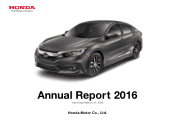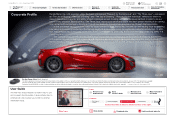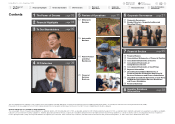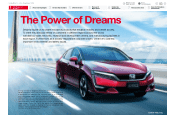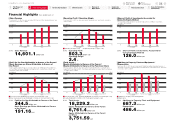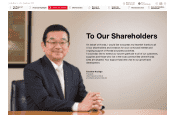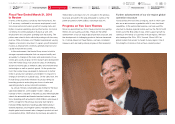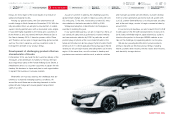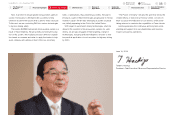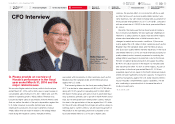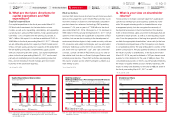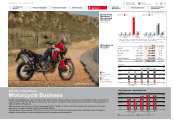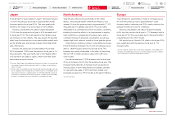Honda 2016 Annual Report Download - page 10
Download and view the complete annual report
Please find page 10 of the 2016 Honda annual report below. You can navigate through the pages in the report by either clicking on the pages listed below, or by using the keyword search tool below to find specific information within the annual report.
CFO Interview
associated with movements of other currencies (such as the
Brazilian real, the Canadian dollar and the Mexican peso)
against the U.S. dollar.
The forward guidance for the fiscal year ending March 31,
2017 is a decline in sales revenue of 5.8% to ¥13,750 billion,
along with 19.2% growth in operating profit to ¥600 billion*.
We expect Honda group unit sales to rise in automobile busi-
ness operations primarily due to growth in North America and
Asia, but we anticipate lower revenue after currency transla-
tion due to the appreciation of the yen against the U.S. dollar.
On the profit side, although the stronger yen will be a drag on
earnings due to currency effects, we are expecting growth of
¥96.6 billion at the operating profit level compared to the
fiscal year ended March 31, 2016 due to higher sales
volumes, the positive effect of cost reduction efforts as well
as other factors such as lower quality related product war-
ranty expenses. Our yen-dollar exchange rate assumption for
the fiscal year ending March 31, 2017 is ¥105/$1, compared
with an actual rate of ¥120/$1 in the fiscal year ended March
31, 2016*.
Recently, the main issue that we have faced at Honda is
how to improve profitability. We face particular challenges in
relation to 1) sales volumes in Japan, Asia and other regions
where sales have fallen short of initial forecasts due to
changes in market and economic conditions, 2) the move-
ments against the U.S. dollar of other currencies (such as the
Brazilian real, the Canadian dollar, and the Mexican peso),
and 3) product quality related warranty expenses. In the fiscal
year ended March 31, 2016, we made financial provisions for
quality related product warranty expenses for resolving the
airbag inflator issue based on projected costs for the future.
We aim to balance global production and supply by selling
80–90% of local production in the region it is manufactured
and exporting the other 10–20% to other regions. As part of
this system, in the fiscal year ended March 31, 2016 we
expanded exports from Japan to the North American market,
where we have insufficient production capacity. To respond to
currency fluctuations against the U.S. dollar, besides reinforc-
ing our mutually complementary supply capabilities, we are
also continuing to promote efforts to increase the ratio of
locally procured parts.
* As of June 16, 2016
Q. Please provide an overview of
Honda’s performance in the fiscal
year ended March 31, 2016 and the
major related issues.
We recorded higher sales but lower profits in the fiscal year
ended March 31, 2016, with a 9.6% year on year increase in
consolidated sales revenue to ¥14,601.1 billion and a 24.9%
decline in operating profit to ¥503.3 billion. Revenue was
boosted by higher sales of automobiles in North America and
Asia, as well as the effect of the yen’s depreciation against the
U.S. dollar. However, our profits declined year on year,
depressed by provisions for product warranties of about
¥436.0 billion that we made in relation to the airbag inflator
recall along with negative currency translation effects
Kohei Takeuchi
Senior Managing Officer
and Director,
Chief Financial Officer
Honda Motor Co., Ltd. Annual Report 2016 09
4CFO Interview
Return to last
page opened
Go to
contents page
2Financial Highlights
3To Our Shareholders
5Review of
Operations
6Corporate
Governance
7Financial Section
8Investor Relations
Information
1The Power of
Dreams

